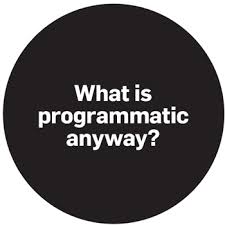Digiday Programmatic Marketing Summit

Shortly after Memorial Day, Digiday hosted their Programmatic Summit in Austin, Texas. There programmatic folks from agencies, consultancies and brands met to discuss trends and advancements in programmatic, where the industry is going and what issues still exist. While there was still talk of transparency and the fact that most have attempted to do so – there was still a heavy belief that programmatic was still a black box. Where we now have supply chain transparency and the ability to have access to bidstream data there is still an inability to process that bidstream data while also new "solutions" in place that need to be explained like bid shading.
Key facts that came from the panels which ranged from audio to supply chain transparency:
- Programmatic accounted for 82.5% of the total US digital display budget
- By 2020, 83.8% of digital video dollars will be transacted via automated channels
- Programmatic will account for 7% of all linear TV dollars by 2020
- DOOH will go from @$2.5B in 2018 to $3.2B in 2020. That accounts for 30% of all DOOH spend
- Ad supported streaming audio will continue to accelerate as US adults listen to an average of 2 hours daily
- Days of publishers running yield optimization in a waterfalled approach are no longer. Publishers are managing yield based on CPMs and price point and not "direct v. programmatic"
- 50% of all listeners trust audio ads more if they hear them during a podcast
- 81% of listeners have taken an action in response to podcast advertisements
- An increasing number of podcast companies are relying on dynamic ads that are downloaded at the time of podcast download to serve video ads
- These ads can be host read, producer read, or pre-recorded elsewhere for delivery
- Audio ads have new measurement capabilities available from companies such as Barometric and Google Campaign Manager
- People-based platforms are springing up to combat the death of the 3rd party cookie. But this is something that needs to be properly vetted as a lot of platforms are simply smoke and mirrors
The eight things we learned:
- Everyone wants more transparency – and is waiting on everyone else to do it
During a working group session lead by myself – publishers wanted agencies to push their DSPs to be willing to pass all details of the buy via the bidstream. Marketers and agencies wanted clear understanding of where dollars were lost in the chain. Resellers wanted to remain in the eco-system.
Said by one of the publishers "Publishers have no fucking power at all. It's really about the agencies or the in-house clients to demand true transparency."
Said by an agency "The power doesn't sit with the agency or the marketer because, at the end of the day, I'm tied to a tech stack."
- Programmatic know how is hard to come by
No surprise here. Staffing programmatic specialists is hard to come by and the folks who are in place are poached quite often. Brands are resorting to guerilla efforts to take talent from agencies and/or left to train staff on their own. Some marketers point to this as one of the reasons why agencies are still acting as QA or consultancies for their in-house programmatic practices and has slowed down in-housing.
Agencies must take the time to educate their clients on programmatic and the industry changes. Placing specialists in front of client to discuss new and emerging tech fosters a sense of comradery and makes it easier to innovate quickly.
- Brands are taking more control over programmatic, leading everyone to try to work with them directly
As seen with Adobe, Google and numerous other folks, as brands get a better handle of programmatic – vendors and tech providers are using that to speak directly to brands in an attempt to sway marketers into tying themselves to one provider rather than focus on what is best for the campaigns running. Agencies while many times are forced to still conduct the tests should not be afraid to provide their POVs to their clients regarding tech and platforms. Most clients / marketers said they welcome their agencies thoughts and would appreciate their POVs if presented with it.
- In-housing can be a money save if a brand is able to hire the right people and negotiate favorable deals. The real value is control of the data
Brands have pivoted from the thought that in-housing can save them money and understand that agencies have the scale to provide cost savings that offset their tech and labor fees in most cases. As said during a panel "[Agencies] can get rates that are incredibly low compared to what we'd get. It would be much more expensive than what we're paying today. Are the fees we'd be paying above what a large media buying agencies would pay greater than the saving we'd see [in-house]? Right now, the answer is no [to in-housing]."
The true benefit to in-housing that most brands (like Uber who presented how they have set up their in-house programmatic practice) is having control over their first party data and using that to power their programmatic campaigns.
- Collaboration is crucial because so many of programmatic's problems seem to stem from lack of communication
Agencies who have said they are not concerned about in-housing said that was the case because they were transparent with their clients and act as a consultant. They have found success by allowing the client access to the programmatic teams, ability to reach out to them directly and generate a sense of learning and collaboration directly with their programmatic specialists. By doing this the client felt as though they were a part of the decisions being made rather than seeing programmatic as a black box line item on their media plans.
Best said by Claudia Beale, digital media supervisor at SafeAuto. - "We're really pushing focus on the communication because it's one of those things where, when you have an agency, everyone is playing telephone,"
- Programmatic buying options for TV, CTV and Audio are emerging but underdeveloped
More so with audio and linear TV, while the pipes exist for them the measurement of it is not quite there yet. Knowing that VCR and LTR are table-stakes, agencies are looking for additional measurement capabilities and ways to be able to gauge the effectiveness of those campaign types. Linear tv continue to lag behind, but as device graphs are refined, programmatic buying within linear TV will continue to grow.
- The cookie is all but extinct, and its alternatives are endangered
With Apple rolling out changes to the life of the cookie, and Google following after the largest concern was less about targeting users but more about how to measure performance of those campaigns as cookie-based attribution is still king. Agencies with B2B or clients whose products had longer purchase consideration windows expressed concern stating that we will need another way to measure digital effectiveness.
- The programmatic auction is changing, and everyone has to adjust
Long gone are the days of waterfall management on the publisher side and second price auction. Though the last to make the change, Google's move to first price auctions signaled the changing of the guard for how all parties look at programmatic auctions. Publishers are now accustomed to looking at the CPM of a campaign regardless of whether it was brokered direct or programmatic and media buyers are excited that they are allowed to pass the actual max bid price they are willing to pay (minus fees) throughout the chain rather than the previously won auction maximum.
Overall, we came away finding areas where Havas can improve our programmatic practice and areas where we are ahead of the curve.
Havas has been proactive with being transparent via our SSP transparency agreements that we have worked out with our SSP partners. We currently have 7 SSP partners and have seen improvements with brand safety and an increase in working media dollars. Additionally, with this agreement we have access to log level data at the advertiser level, which in part provides transparency in pricing, thus allowing us to make better decisions and be more aggressive about altering our bidding strategy to increase the amount of dollars that go to the publisher (decreasing the ad tech tax).
Havas Programmatic has already been testing linear tv pipes and have included CTV and audio on many of our FY year plans as a standard offering. DOOH has become an area where our programmatic team has developed deep expertise as well. As the linear TV landscape continues to evolve we will do so as well – ensuring we remain ahead of the curve.
We have seen improvements with having the programmatic team engage directly with the clients becoming a more holistic Havas media partner to them. Havas Programmatic has started the process of presenting our media recommendations to clients as well having presented Programmatic 101, 102 and more in-depth presentation overviews. This has allowed us to give voice to the programmatic business offerings via Havas. This is where we can continue to evolve the One Village voice with possible inclusion to all aspects of the media discussion, from strategizing overall marketing efforts to creative and messaging concepts to inclusion of budgeting allocations. While we have seen improvement here – creating programmatic training regimens for clients and increased presence with clients during the planning and execution stages will only help to decrease that black box that programmatic can sometimes be considered.
Click the social buttons above or below to share this story with your friends and colleagues.
The opinions and points of view expressed in this content are exclusively the views of the author and/or subject(s) and do not necessarily represent the views of MediaVillage.com/MyersBizNet, Inc. management or associated writers.



